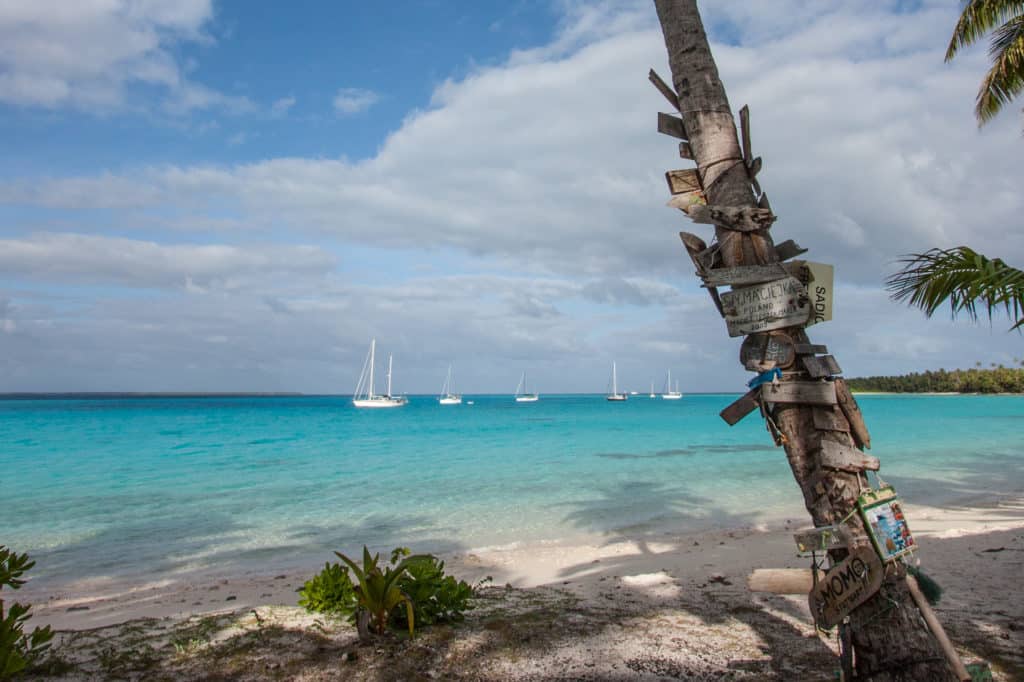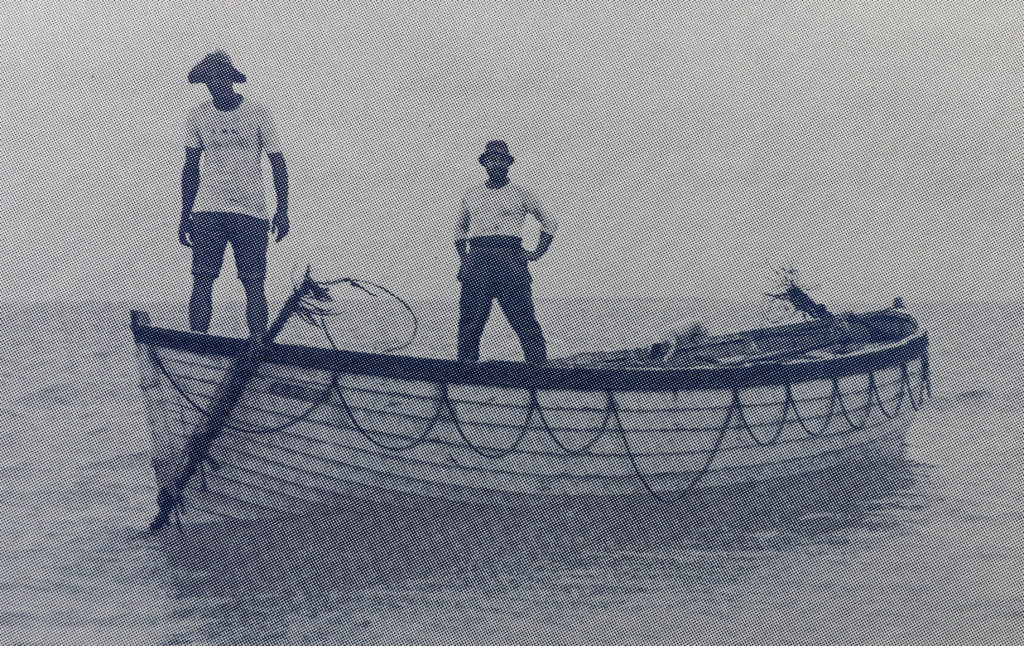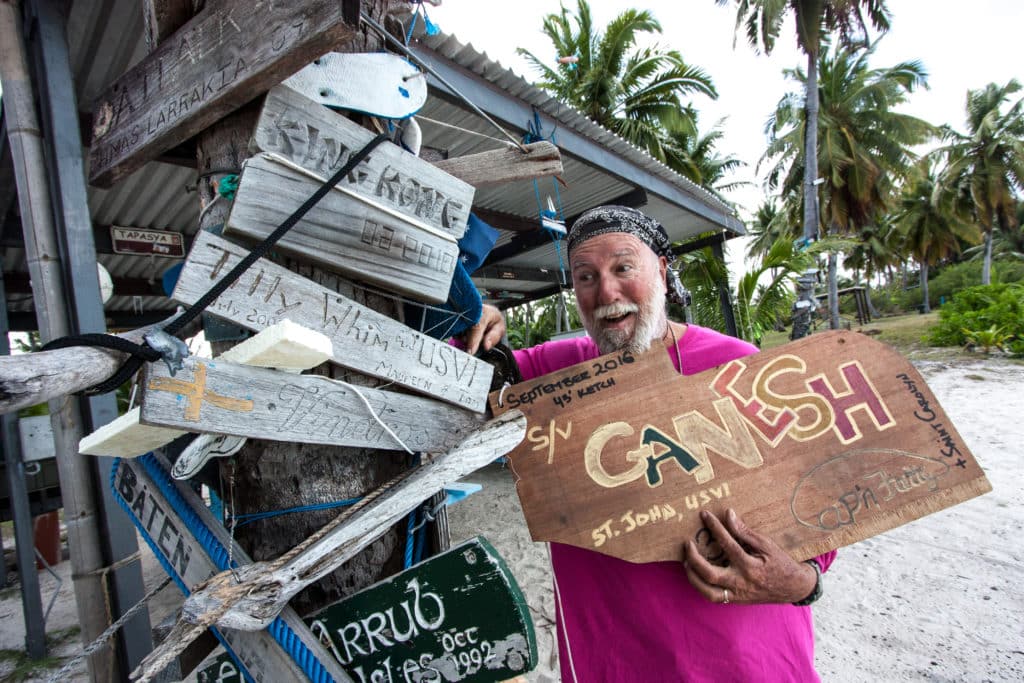
Occasionally my lives as a sea gypsy and an entrepreneur collide because I have to wear so many hats: captain, husband, writer, lover, sailor and money-grubber, to name but a few. When they do, odd things happen.
For example, a tasty little copywriting job came to me recently in the middle of the Indian Ocean via Sailmail, which I received via our single-sideband radio. The writing took only a few days. Then all I needed was to spend an hour or two on the Internet fact checking, and another three months of cruising funds would be direct-deposited. Sweet!
Only one problem: Where would I find the nearest Wi-Fi hotspot in the windiest, wettest ocean on Earth?
“Cocos Keeling,” my wife, Carolyn, said without blinking. “Three hundred miles dead ahead. It’s perfect, Fatty. Direction Island is historically all about international communication — from its 1901 telegraph office to its World War II underground telephone cable to its wooden Post Office barrels that Joshua Slocum used to write home to its currently credit-card-enabled Wi-Fi’d harbor.”
“I thought Direction Island was deserted, that nobody lived there,” I said.
“It is,” said Carolyn, “and they don’t. But that doesn’t mean it isn’t broadbanded.”
See how conflicting modern cruising can be? As a professional ink slinger in need of freedom chips, I was delighted. But as an ocean vagabond, I was appalled. Nonetheless, smarty-pants Carolyn had the answer to my every question. “Really?” I asked. “Carolyn, is there anything you don’t know?”
“How to judge a man,” she replied.
Known officially as Cocos (Keeling) Islands, this Indian Ocean landfall is a territory of Australia and is approximately 1,200 nautical miles equidistant between the motherland and Singapore. It was discovered by William Keeling of the East India Company in 1609, and is rarely visited because of its remoteness. The only vessels that normally transit are small yachts on their way to South Africa, 4,000 windy miles to leeward. Besides its location, the waters surrounding Cocos are rough. Just outside the placid harbor, the Indian Ocean trades regularly gust to gale force. We barely managed to find the lee; twice I had to turn back for lack of visibility during violent squalls as we approached the tiny, wind-swept island, one of several in South Keeling.
We expected the harbor to be deserted, but there were five or six stout cruising yachts at anchor in the lee of Direction. Australian Customs and Immigration was kind enough to come to us from nearby inhabited Home Island to grant clearance. As soon as our vessel formalities were complete, Carolyn booted up her computer to surf the Internet. “Ah, the Wi-Fi server is up!” she muttered to herself as I slipped away in the dinghy, eager to search for the famed postal barrel of yore.

As a young sailor boy, I’d dreamed of islands like Cocos in the Indian Ocean and Floreana, in the Galapagos. Both had wooden barrels that sailing ships used as informal post offices in the 18th and 19th centuries. I believe it started with the South Pacific whalers. Those working the fishing grounds would drop off letters for home during the course of their two-plus-year voyages, while vessels heading back to civilization would fly a long, red homeward-bound pennant from their masthead and stop to scoop up the letters. Postage was free, and returning sailors were honor-bound to make sure the letters actually arrived at their destination, even if a year or three late.
Direction Island had one of the most famous and longest-lived barrel post offices because both tramp steamers and cruise ships used to stop by, toss over a line, and the local men would wade along the beach to grab the incoming mail and release the outgoing in sealed, waterproof tins.
One cruise-ship line asked their passengers — a sizable number of whom were wealthy females — if they wanted to write to the lonely men on the island, and many did. It became a regular thing, and some steamy-if-anonymous missives resulted. One local resident wrote back, expressing a desire for a cat; once the word was out of the bag, many a ship dropped off a basketful of kitties with the mail. This wreaked havoc with the bird population — ah, the misery of unexpected consequences. Alas, after hiking the entire island, I found only a historical plaque marking the spot where the barrel once rested, not the actual postal bin itself. I felt strangely cheated. Perhaps a passing vessel had carted it away as a famous antique or a local had chopped it up for firewood. Damn! Why couldn’t such a lovely maritime tradition carry on to this day?
By the time I got back to Ganesh, our 43-foot Wauquiez Amphitrite ketch, I could see Carolyn was frustrated. “I think we’re anchored too far out,” she said. “I can’t actually connect to the Wi-Fi. Can we move in closer?”
This has been a point of contention between us. Carolyn always wants to be cyber-connected. I do not. I’m more of a log-off, cast-off and sail-away kind of guy. And so I often tell her, “I didn’t voyage here to check Facebook,” when I refuse to move within range of such cyber-bedevilment. But this was dollars-and-cents business, an official put-food-on-the-galley-table necessity, so I swallowed my pride and we moved closer to the beach.
The following day, we went in search of the once-busy telegraph station that became operational on Direction Island in 1901. All we could find, though, was a rusty, vine-encrusted cistern. Scratch off one more way to communicate with the outside world.
While ashore, we did managed to hunt down the Wi-Fi antenna aimed at the harbor. Its solar cell looked OK atop a telephone pole, and no one had tampered with the locked box that held its battery.
That evening, Carolyn reported she was “in” on the Wi-Fi router, but it wouldn’t accept her credit card.
“The coconut telegraph was more dependable,” I quipped.
“True,” she said, “But you need island people to have island rumors.”

My next shore quest was to find where the famed undersea cable that brought communications to the Indian Ocean came ashore. I thought this would be easy, but it wasn’t. However, I did stumble upon a massive amount of broken steel and concrete on the windward side of Direction, which may or may not be related to the cable.
The past is never far behind while beachcombing anywhere on Cocos Keeling’s 27 islands. While I could not find the 160-foot radio mast that was erected in 1910, I felt the ghost of the much-respected Capt. Karl Friedrich Max von Müller, a World War I German sailor who briefly captured the island in such a gentlemanly way (he was careful not to bomb the tennis courts) that his eventual captors became his lifelong friends and fierce defenders.
There were still some craters on the island that might have been the result of World War II Japanese bombs dropped in 1942. The islanders were smart. While the strategic underwater cable that ran from Singapore, Australia and South Africa was undamaged, they took a photograph of a small spare section that appeared to be heavily hit, and told the Allies to report that the whole station and its cable had been wiped out. Whether the Germans and Japanese fell for the ruse nobody knows, but there were no further wartime attacks on Direction Island or its cable station.
“Still haven’t been able to cyber-connect?” I asked Carolyn as we made a signboard to hang on a palm tree, another delightful Cocos maritime tradition.
“No,” she scowled. “At first I thought it might be a credit-card-verification problem; now I’m convinced the Wi-Fi server isn’t actually connected to the Internet at all.” “Poor dear,” I said. “Going cold turkey on Facebook must be a drag.”
“Don’t start!” she said. “I haven’t twittered in so long, I’ve forgotten how to tweet!”
As the island days — and daze — flew past, we met our fellow cruisers. Paul and Celeste Carpenter, aboard the Valiant 40 Benguine, offered to let us use their SatPhone to email my manuscript. We were soon inviting each other over for cockpit dinners and rum-fueled laughs. He’s a retired fireman from California, and she’s on her 21st year of living aboard.
Two youthful sailors from Australia sailed in. Rhys Brindley and Trevor Youngberg were new to cruising and having the time of their young lives. They immediately dropped their hook next to Ganesh and dashed off to snorkel the pristine reef (nice!) and to spear their dinghy (not so nice) when a too-clever parrotfish confused their field of fire.
We immediately took them under our parental wing, and eventually we all crossed the entire Indian Ocean in tandem — even after they 1) drunkenly flipped their dinghy twice in the same evening; 2) got their wallets stolen; and 3) begged the fishermen of Mauritius to bust beer bottles over their heads. (Fishermen the world over tend to accommodate such requests, but gosh, the youngsters were having some Aussie-style fun!)
Finally Carolyn dejectedly admitted defeat. “I can’t connect to the Internet here,” she said. “We’ll have to get to Home or West Island with a sack of cash and avail ourselves of their satellite uplink.”
I smiled. The entrepreneur in me was disappointed, but the sea gypsy was delighted. Because Direction Island lacked a functioning Wi-Fi hotspot, it was actually more out of communication with the rest of the world than it had been any time in the past couple of centuries. It had no barrel post office, no telegraph, no underwater cable, no radio tower and no Internet.
Carolyn was in the final stages of cyber-withdrawal that day last fall. She needed a shot of Google, a dash of Instagram and a hint of Whisper to mentally right herself. “You poor, info-starved thing,” I taunted.
“I want to find out what is happening with the election,” she said.
“Are you sure?” I fired back.
Fatty and Carolyn spent the holiday season gorging with the Zulu meat eaters of South Africa.








